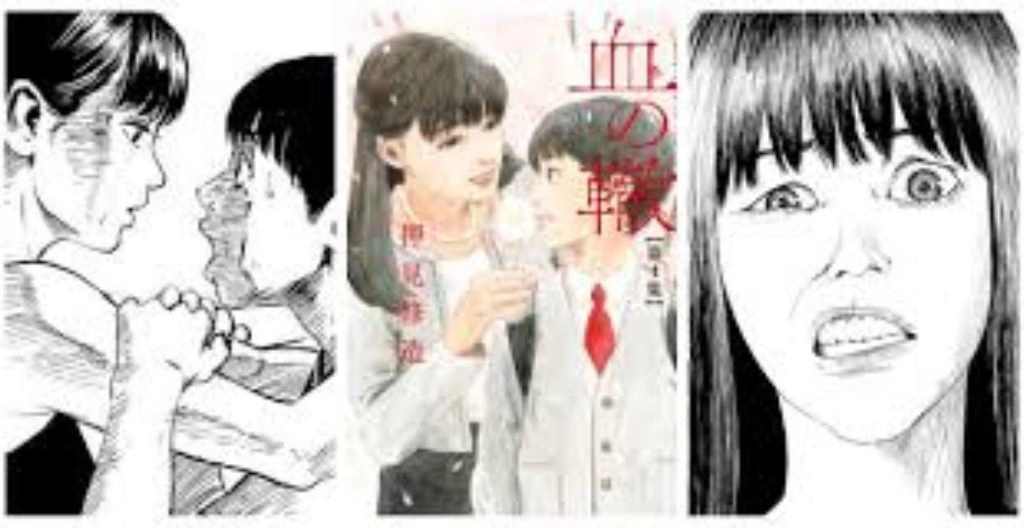The Blood on the Tracks manga is a gripping and intense psychological horror series that has captured the attention of readers worldwide.
Written and illustrated by Shūzō Oshimi, this manga delves deep into the dark and twisted relationship between a mother and her son, exploring themes of control, manipulation, and the consequences of a toxic bond.
Set against the backdrop of a seemingly normal suburban life, the story’s horror unfolds with chilling realism. As the narrative progresses, readers are drawn into a world where the line between love and obsession becomes dangerously blurred.
Unlike typical horror manga, this series uniquely captures the essence of psychological fear—the kind that crawls under your skin and stays with you long after you’ve closed the book.
By combining nuanced storytelling with profoundly impactful visuals, Blood on the Tracks elevates itself as a masterpiece in the genre, leaving an indelible mark on its readers.
Its resonance lies not just in its shocking moments but in its ability to evoke reflection on the fragile dynamics of human relationships.
What Is Blood On The Tracks Manga?
Blood on the Tracks (Chi no Wadachi in Japanese) is a psychological horror and drama manga series written and illustrated by Shūzō Oshimi. Serialized in Big Comic Superior since February 2017, it has gained significant acclaim for its intense and unsettling narrative.
The story’s genius lies in its ability to pull readers into a deceptive calm. At first glance, it seems like a slice-of-life tale of a mother and son, but beneath the surface lurks an emotional abyss.
This duality—between the ordinary and the horrific—is what keeps readers hooked, eager to unravel the deeper truths hidden in every panel. Each chapter peels back layers of psychological tension, revealing a chilling depth of human vulnerability and dysfunction.
Why Is Blood on the Tracks Manga So Popular?
Blood on the Tracks has carved a niche in the psychological horror genre due to several standout qualities:
- Intense Psychological Depth: The narrative explores the complexities of human emotions and relationships, making each character’s decisions and struggles relatable yet haunting.
- Relatable Yet Terrifying Settings: Juxtaposing the normalcy of suburban life with dark psychological themes heightens the horror.
- Masterful Storytelling: Shūzō Oshimi’s ability to evoke emotional and psychological tension captivates readers, making them feel as though they’re part of Seiichi’s world.
- Universal Themes: The manga’s exploration of guilt, love, fear, and betrayal resonates across cultures, appealing to a global audience.
The manga’s popularity is also bolstered by its relatable portrayal of familial love and its potential to become toxic. Fans are drawn to the story’s raw honesty and its refusal to shy away from uncomfortable truths about family dynamics.
ALSO READ: Ippo Manga: Everything You Need To Know About Popular Boxing Manga
The Genius Creator: Shūzō Oshimi
Shūzō Oshimi is renowned for exploring the darker aspects of the human psyche. His works, including Flowers of Evil and Happiness, often delve into strained relationships and emotional turmoil. With Blood on the Tracks, Oshimi masterfully blends narrative and artwork to create a visually and emotionally immersive experience.
Art Style and Technique
- Subtle Expressions and Body Language: Oshimi uses minimalistic yet powerful visual cues to depict internal conflicts. A single glance from Seiko can convey suffocating dread, while Seiichi’s expressions speak volumes about his silent agony.
- Themes: He excels at depicting toxic relationships, psychological manipulation, and the fragility of innocence, making the characters feel multidimensional.
- Emotional Layers: Oshimi’s art provides layers of depth—what appears serene at first glance often hides disturbing undercurrents.
By merging masterful artwork with evocative storytelling, Oshimi creates an unforgettable reading experience that pushes the boundaries of psychological horror. His ability to visualize tension and subtle emotions ensures that even silent moments in the manga are laden with impact.
The Storyline
The story centers on Seiichi Osabe, a seemingly ordinary boy with a close bond with his mother, Seiko. However, Seiko’s overprotectiveness spirals into psychological manipulation, trapping Seiichi in a web of control.
As the narrative unfolds, readers witness the devastating impact of this toxic relationship. Seiichi’s mental struggles mirror those of real-life individuals caught in manipulative dynamics, making his journey both heart-wrenching and eerily familiar.
The manga forces readers to grapple with uncomfortable questions: How far can love go before it becomes destructive? And what happens when the one meant to protect you becomes your greatest fear?
This journey through Seiichi’s psyche is as gripping as it is tragic. As he oscillates between yearning for his mother’s approval and the instinct to break free, readers are left on edge, wondering whether salvation or devastation awaits him.
Key Themes Explored
- Parental Control: A chilling portrayal of how love can become a weapon of manipulation.
- Psychological Trauma: The narrative delves into guilt, fear, and the irrevocable loss of innocence.
- Trust and Betrayal: Highlighting the devastating betrayal from those we trust most.
- Identity Crisis: Through Seiichi, the manga examines how external control can erode one’s sense of self, leaving lasting scars.
- Human Resilience: Despite the horror, the story subtly hints at the resilience of the human spirit, offering glimmers of hope amidst despair.
- Cycle of Abuse: The manga subtly explores whether cycles of toxic relationships can be broken, or if they perpetuate through generations.
Art of Blood on the Tracks
The manga’s artwork plays a pivotal role in conveying its haunting narrative:
- Subtle Visuals: Oshimi’s use of facial expressions and body language portrays inner turmoil with striking clarity.
- Atmospheric Shading: Dark compositions and shadowy contrasts amplify the tension, creating a sense of foreboding in every panel.
- Juxtaposition: Ordinary suburban settings heighten the impact of psychological horror, reminding readers that monstrosity can lurk in the most mundane of places.
Every frame of the manga is meticulously crafted to enhance the emotional resonance, making the visuals as essential to the storytelling as the plot itself. Oshimi’s use of sparse dialogue and evocative imagery invites readers to interpret the silent spaces between actions, deepening the psychological impact.
Reception of Blood on the Tracks
Since its debut, Blood on the Tracks has received critical acclaim for its daring approach to psychological horror:
- Narrative Mastery: The slow-burn storytelling and intense character development captivate readers, keeping them invested in Seiichi’s harrowing journey.
- Realism: Its depiction of emotional manipulation resonates deeply, sparking discussions about toxic relationships and mental health.
- Cultural Impact: The manga’s universal themes have transcended cultural barriers, making it a global phenomenon.
Critics and fans alike laud the series for its ability to immerse readers in a world where every decision feels consequential, and every glance carries weight. It has also inspired discussions about the broader societal implications of parental overreach and the importance of autonomy in growth.
Comparisons with Other Psychological Horror Works
| Aspect | Blood on the Tracks | Flowers of Evil | The Drifting Classroom |
|---|---|---|---|
| Author | Shūzō Oshimi | Shūzō Oshimi | Kazuo Umezu |
| Main Theme | Parental control | Teenage rebellion | Survival horror |
| Focus | Mother-son relationship | Adolescent relationships | Children in crisis |
| Art Style | Subtle, expressive | Realistic, emotive | Detailed, surreal |
| Psychological Elements | Manipulation, guilt | Repression, guilt | Trauma, fear |
| Target Audience | Mature readers | Dark psychological fans | Classic horror fans |
| Emotional Depth | High | Medium | Medium |
Impact of Blood on the Tracks
- Broader Discussions: The manga’s exploration of parental love and control has opened dialogues about family dynamics and mental health, challenging readers to reflect on their relationships.
- Spotlight on Toxic Relationships: By depicting the slow erosion of Seiichi’s autonomy, it raises awareness of how toxic relationships affect long-term well-being.
- Empathy and Awareness: The series fosters empathy by showing how seemingly “good” intentions can spiral into harm, encouraging readers to consider the nuanced dynamics of control and care.
Role of Tension
Tension is the driving force of Blood on the Tracks:
- Pacing: The slow buildup amplifies suspense, ensuring that each revelation lands with maximum impact.
- Psychological Manipulation: Seiko’s actions create an oppressive atmosphere, making readers feel the weight of Seiichi’s struggle.
- Reader Engagement: Gradual revelations and subtle hints keep readers constantly guessing, adding layers of complexity to the story.
Character Development
- Seiichi Osabe: His tragic journey from innocence to emotional turmoil is both heartbreaking and compelling. As the narrative progresses, Seiichi’s internal conflicts become a mirror for readers’ own fears and insecurities.
- Seiko Osabe: A complex figure whose actions stem from a distorted sense of love. Her character challenges readers to consider the fine line between care and control, making her one of the most haunting antagonists in modern manga.
- Supporting Characters: Other characters, though less central, provide critical contrasts to Seiichi’s experiences, amplifying the story’s themes.
Psychological Horror: The Heart of the Manga
At its core, Blood on the Tracks is a chilling exploration of psychological horror:
- Themes of Control: Examining how love can morph into a weapon, stripping individuals of autonomy.
- Reflection on Humanity: Forcing readers to confront uncomfortable truths about trust, dependency, and betrayal.
- Unsettling Realism: The story’s plausibility heightens its horror, as it exposes the fragility of human relationships.
ALSO READ: Leviathan Manga: A Deep Dive into the World of Colossal Stories
Conclusion: Why You Should Read Blood on the Tracks
Blood on the Tracks is a masterful psychological horror series that offers an unsettling yet thought-provoking experience. With its rich character development, compelling narrative, and exploration of dark themes, this manga is a must-read for fans of psychological drama and horror. Dive into the twisted world of Blood on the Tracks and discover a story that will linger in your mind long after you’ve turned the final page.
Ready to experience the chilling brilliance of Blood on the Tracks? Pick up a copy today and unravel the dark secrets within.
Frequently Asked Questions
Q: What is Blood on the Tracks manga about?
A: It’s a psychological horror series that delves into a dark mother-son relationship, focusing on themes of control and manipulation.
Q: Who created Blood on the Tracks manga?
A: The manga is written and illustrated by Shūzō Oshimi, known for his exploration of complex psychological themes.
Q: Why is Blood on the Tracks so popular?
A: Its popularity stems from its intense psychological depth, compelling narrative, and unique portrayal of familial relationships.







